Urban Freight Last Mile Logistics—Challenges and Opportunities to Improve Sustainability: A Literature Review
Abstract
1. Introduction
1.1. Driving Forces behind the Growth of Urban Freight Flow
1.2. Definitions
1.3. Urban Freight Last Mile Logistics (LML)
- Q1—What are the main types of freight LML logistics configurations?
- Q2—What are major challenges causing inefficiency of urban freight LML?
- Q3—What are opportunities for interventions to improve sustainability of urban freight LML?
1.4. Objectives
2. Methodology
2.1. Literature Search
2.2. Analysis Approach
3. Typology and Characteristics of LML
4. Challenges of Freight LML
4.1. Technological Aspect
4.2. Infrastructural and Planning Aspect
4.3. Freight LML and Management Aspect
4.4. Cost Related Challenges
5. Opportunities for Improving the Sustainability Performance of LML
5.1. Opportunities for Improving Environmental Sustainability
5.2. Opportunities for Improving Economic Sustainability
5.3. Opportunities for Improving Societal Sustainability
6. General Discussion and Future Research
6.1. General Discussion
6.1.1. Technological Innovation and Urban Freight LML
6.1.2. Urban Freight LML System and Management
6.1.3. Sustainability of Freight LML
6.2. Future Research
- In the supply chain management, more attention has been given to manufacturing issues than transportation [37]. Especially, LML has become a research topic very recently [17,34]. However, more investigation is required on LML management, e.g., addressing topics such as subcontracting [44] of LML services’ conflicting interests of multiple stakeholders [29,30].
- The typology analysis has resulted in three major potential LML configurations. In depth quantitative analyses could be conducted to identify more sustainable LML options.
- The rapidly growing online shopping, OC business, and their impacts on LML, have potential research stream in near future [6,20]. Such studies can be designed considering goods delivery failure and its management, packaging, delivery scheme, delivery time window, transport distance, warehouse (or retailer) location, ICT infrastructure, vehicle type, and load factor, etc.
- The comparison of conventional and online retailing requires more complex and detailed research works [35]. This type of study could be conducted taking into consideration factors such as geographical variations, urban variation, and goods variation.
- Within rapidly changing urban environments, the awareness of urban residents and authorities increases. This leads to changes of logistics-related policies and regulations. This makes logistics planning and management issues more complex and difficult [7,45]. Therefore, more strategic research of urban freight LML performances are essential.
- Emerging technologies such as 3D printing for localized goods production and UAVs for freight delivery [36] and digitization and automation technologies for logistics management [13] could lead to interesting innovative LML solutions. In this regard, it is important to standardize and define the use of technical terms related to LML. The performance of these innovative LML solutions should be assessed in the future as their application is scaled up.
- Existing studies related to LML focus on one or two aspects of sustainability. Integrated research projects that consider the environmental, economic, and societal aspects are needed to develop sound knowledge base and improve sustainability of LML activities.
7. Conclusions
Funding
Acknowledgments
Conflicts of Interest
References
- Ranieri, L.; Digiesi, S.; Silvestri, B.; Roccotelli, M. A Review of Last Mile Logistics Innovations in an Externalities Cost Reduction Vision. Sustainability 2018, 10, 782. [Google Scholar] [CrossRef]
- Sheth, M.; Butrina, P.; Goodchild, A.; McCormack, E. Measuring delivery route cost trade-offs between electric-assist cargo bicycles and delivery trucks in dense urban areas. Eur. Transp. Res. Rev. 2019, 11, 11. [Google Scholar] [CrossRef]
- Nenni, M.E.; Sforza, A.; Sterle, C. Sustainability-based review of urban freight models. Soft Comput. 2019, 23, 2899–2909. [Google Scholar] [CrossRef]
- Visser, J.; Nemoto, T.; Browne, M. Home Delivery and the Impacts on Urban Freight Transport: A Review. Procedia Soc. Behav. Sci. 2014, 125, 15–27. [Google Scholar] [CrossRef]
- Cleophas, C.; Ehmke, J.F. When Are Deliveries Profitable? Bus. Inf. Syst. Eng. 2014, 3, 153–163. [Google Scholar] [CrossRef]
- Melacini, M.; Perotti, S.; Rasini, M.; Tappia, E. E-fulfilment and distribution in omni-channel retailing: A systematic literature review. Int. J. Phys. Distrib. Logist. Manag. 2018, 48, 391–414. [Google Scholar] [CrossRef]
- Cardenas, I.; Borbon-Galvez, Y.; Verlinden, T.; Van de Voorde, E.; Vanelslander, T.; Dewulf, W. City logistics, urban goods distribution and last mile delivery and collection. Compet. Regul. Netw. Ind. 2017, 18, 22–43. [Google Scholar] [CrossRef]
- Allen, J.; Piecyk, M.; Piotrowska, M.; McLeod, F.; Cherrett, T.; Ghali, K.; Nguyen, T.; Bektas, T.; Bates, O.; Friday, A.; et al. Understanding the impact of e-commerce on last-mile light goods vehicle activity in urban areas: The case of London. Transp. Res. Part D 2018, 61, 325–338. [Google Scholar] [CrossRef]
- Castillo, V.E.; Bell, J.E.; Rose, W.J.; Rodrigues, A.M. Crowdsourcing Last Mile Delivery: Strategic Implications and Future Research Directions. J. Bus. Logist. 2018, 39, 7–25. [Google Scholar] [CrossRef]
- Hübner, A.; Kuhn, H.; Wollenburg, J. Last mile fulfilment and distribution in omni-channel grocery retailing a strategic planning framework. Int. J. Retail Distrib. Manag. 2016, 44, 228–247. [Google Scholar] [CrossRef]
- Eurostat. Freight Transport Statistics—Modal Split, Eurostat Database. 2018. Available online: https://ec.europa.eu/eurostat/statistics-explained/pdfscache/1142.pdf (accessed on 20 November 2018).
- Lim, S.F.W.T.; Jin, X.; Srai, J.S. Consumer-driven e-commerce A literature review, design framework, and research agenda on last-mile logistics models. Int. J. Phys. Distrib. Logist. Manag. 2018, 48, 308–332. [Google Scholar] [CrossRef]
- Banyai, T. Real-Time Decision Making in First Mile and Last Mile Logistics: How Smart Scheduling Affects Energy Efficiency of Hyperconnected Supply Chain Solutions. Energies 2018, 11, 1833. [Google Scholar] [CrossRef]
- Gevaers, R.; Van de Voorde, E.; Vanelslander, T. Cost Modelling and Simulation of Last-mile Characteristics in an Innovative B2C Supply Chain Environment with Implications on Urban Areas and Cities. 8th International Conference on City Logistics. Procedia Soc. Behav. Sci. 2014, 125, 398–411. [Google Scholar] [CrossRef]
- Clausen, U.; Geiger, C.; Pöting, M. Hands-on Testing of Last Mile Concepts. Transp. Res. Procedia 2016, 14, 1533–1542. [Google Scholar] [CrossRef]
- De Souza, R.; Goh, M.; Lau, H.-C.; Ng, W.-S.; Tan, P.-S. Collaborative Urban Logistics—Synchronizing the Last Mile a Singapore Research Perspective. Procedia Soc. Behav. Sci. 2014, 125, 422–431. [Google Scholar] [CrossRef]
- Juhász, J.; Bányai, T. Last mile logistics: An integrated view. XXIII International. In Proceedings of the Manufacturing: IOP Conference Series: Materials Science and Engineering, Kecskemét, Hungary, 7–8 June 2018. [Google Scholar] [CrossRef]
- Digiesi, S.; Fanti, M.P.; Mummolo, G.; Silvestri, B. Externalities reduction strategies in last mile logistics: A review. In Proceedings of the IEEE International Conference on Service Operations and Logistics, and Informatics (SOLI), Bari, Italy, 18–20 September 2017; pp. 248–253. [Google Scholar] [CrossRef]
- Dell’Amico, M.; Hadjidimitriou, S. Innovative Logistics Model and Containers Solution for Efficient Last Mile Delivery. Procedia Soc. Behav. Sci. 2012, 48, 1505–1514. [Google Scholar] [CrossRef]
- Van Loon, P.; McKinnon, A.C.; Deketele, L.; Dewaele, J. The growth of online retailing: A review of its carbon impacts. Carbon Manag. 2014, 5, 285–292. [Google Scholar] [CrossRef]
- Pronello, C.; Camusso, C.; Valentina, R. Last mile freight distribution and transport operators’ needs: Which targets and challenges? Transp. Res. Procedia 2017, 25, 888–899. [Google Scholar] [CrossRef]
- Oliveira, C.M.; Bandeira, R.A.M.; Goes, G.V.; Goncalves, D.N.S.; D’Agosto, M.A. Sustainable vehicles-based alternatives in last mile distribution of urban freight transport: A systematic literature review. Sustainability 2017, 9, 1324. [Google Scholar] [CrossRef]
- Alvarez, E.; De La Calle, A. Sustainable practices in urban freight distribution in Bilbao. J. Ind. Eng. Manag. 2011, 4, 538–553. [Google Scholar] [CrossRef]
- Kin, B.; Spoor, J.; Verlinde, S.; Macharis, C.; Woensel, T.V. Modelling alternative distribution set-ups for fragmented last mile transport: Towards more efficient and sustainable urban freight transport. Case Stud. Transp. Policy 2018, 6, 125–132. [Google Scholar] [CrossRef]
- Iwan, S.; Kijewska, K.; Lemke, J. Analysis of Parcel Lockers’ Efficiency as the Last Mile Delivery—The Results of the Research in Poland. Transp. Res. Procedia 2016, 12, 644–655. [Google Scholar] [CrossRef]
- MTI. Using Bicycles for the First and Last Mile of a Commute. Mineta Transportation Institute. MTI Report S-09-02. 2009. Available online: https://transweb.sjsu.edu/sites/default/files/BikeCommute.pdf (accessed on 12 March 2019).
- Qorri, A.; Mujkić, Z.; Kraslawski, A. A conceptual framework for measuring sustainability performance of supply chains. J. Clean. Prod. 2018, 189, 570–584. [Google Scholar] [CrossRef]
- Crainic, T.G.; Ricciardi, N.; Storchi, G.; Storchi, G. Models for evaluating and planning city logistics systems. Transp. Sci. 2009, 43, 432–454. [Google Scholar] [CrossRef]
- Le Pira, M.; Marcucci, E.; Gatta, V.; Inturri, G.; Ignaccolo, M.; Pluchino, A. Integrating discrete choice models and agent-based models for ex-ante evaluation of stakeholder policy acceptability in urban freight transport. Res. Transp. Econ. 2017, 64, 13–25. [Google Scholar] [CrossRef]
- Le Pira, M.; Edoardo Marcucci, E.; Gatta, V.; Ignaccolo, M.; Inturri, G.; Pluchino, A. Towards a decision-support procedure to foster stakeholder involvement and acceptability of urban freight transport policies. Eur. Transp. Res. Rev. 2017, 9, 1–14. [Google Scholar] [CrossRef]
- Perboli, G.; Rosano, M. Parcel delivery in urban areas: Opportunities and threats for the mix of traditional and green business models. Transp. Res. Part C 2019, 99, 19–36. [Google Scholar] [CrossRef]
- Wygonik, E.; Goodchild, A.V. Urban form and last-mile goods movement: Factors affecting vehicle miles travelled and emissions. Transp. Res. Part D 2018, 61, 217–229. [Google Scholar] [CrossRef]
- Nuzzolo, A.; Persia, L.; Polimeni, A. Agent-Based Simulation of urban goods distribution: A literature review. Transp. Res. Procedia 2018, 30, 33–42. [Google Scholar] [CrossRef]
- Ehmke, J.F.; Mattfeld, D.C. Vehicle routing for attended home delivery in city logistics. Procedia Soc. Behav. Sci. 2012, 39, 622–632. [Google Scholar] [CrossRef][Green Version]
- Mitrea, O. (How) will autonomous driving influence the future shape of city logistics? J. Appl. Eng. Sci. 2017, 15, 45–52. [Google Scholar] [CrossRef]
- Mckinnon, A.C. The Possible Impact of 3D Printing and Drones on Last-Mile Logistics: An Exploratory Study. Built Environ. 2016, 42, 617–629. [Google Scholar] [CrossRef]
- Ewedairo, K.; Chhetri, P.; Jie, F. Estimating transportation network impedance to last-mile delivery A Case Study of Maribyrnong City in Melbourne. Int. J. Logist. Manag. 2018, 29, 110–130. [Google Scholar] [CrossRef]
- Banyai, T.; Illés, B.; Bányai, A. Smart Scheduling: An Integrated First Mile and Last Mile Supply Approach. Complexity 2018, 1–15. [Google Scholar] [CrossRef]
- Gomez-Marin, C.G.; Arango-Serna, M.D.; Serna, C.A.; Serna-Uran, C.A. Agent-based microsimulation conceptual model for urban freight distribution. Transp. Res. Procedia 2018, 33, 155–162. [Google Scholar] [CrossRef]
- Edwards, J.; McKinnon, A.; Cullinane, S. Comparative carbon auditing of conventional and online retail supply chains: A review of methodological issues. Supply Chain Manag. Int. J. 2011, 16, 57–63. [Google Scholar] [CrossRef]
- Schliwa, G.; Armitage, R.; Aziz, S.; Evans, J.; Rhoades, J. Sustainable city logistics—Making cargo cycles viable for urban freight transport. Res. Transp. Bus. Manag. 2015, 15, 50–57. [Google Scholar] [CrossRef]
- Karakikes, I.; Nathanail, E.; Savrasovs, M. Techniques for Smart Urban Logistics Solutions’ Simulation: A Systematic Review. In Reliability and Statistics in Transportation and Communication. RelStat 2018; Kabashkin, I., Yatskiv, I., Prentkovskis, O., Eds.; Lecture Notes in Networks and Systems; Springer: Cham, Switzerland, 2019; Volume 68. [Google Scholar] [CrossRef]
- Menga, P.; Buccianti, R.; Bedogni, M.; Moroni, S. Promotion of Freight Mobility in Milan: Environmental, Energy and Economical Aspects. World Electr. Veh. J. 2013, 6, 1014–1020. [Google Scholar] [CrossRef]
- Ducret, R. Parcel deliveries and urban logistics: Changes and challenges in the courier express and parcel sector in Europe—The French case. Res. Transp. Bus. Manag. 2014, 11, 15–22. [Google Scholar] [CrossRef]
- Lim, S.F.W.T.; Winkenbach, M. Configuring the Last-Mile in Business-to-Consumer E-Retailing. Calif. Manag. Rev. 2018, 61, 132–154. [Google Scholar] [CrossRef]
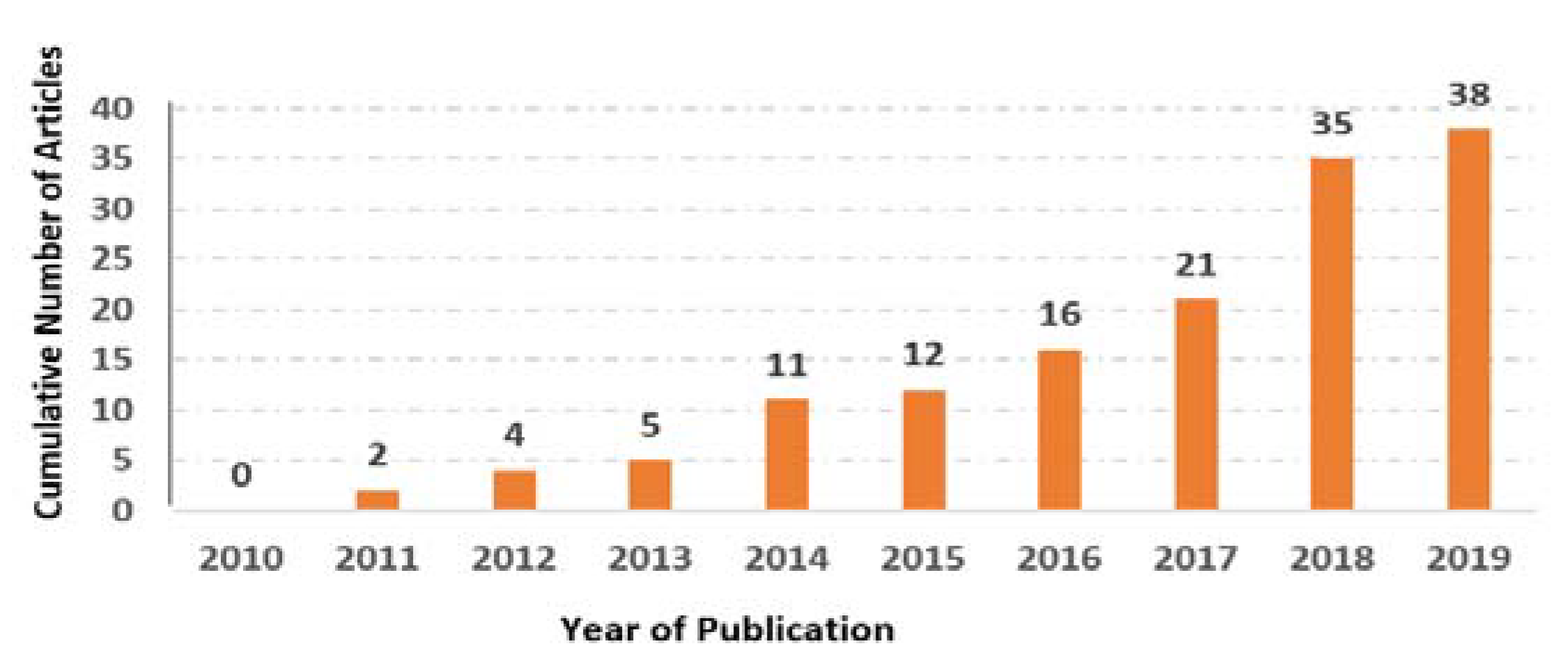
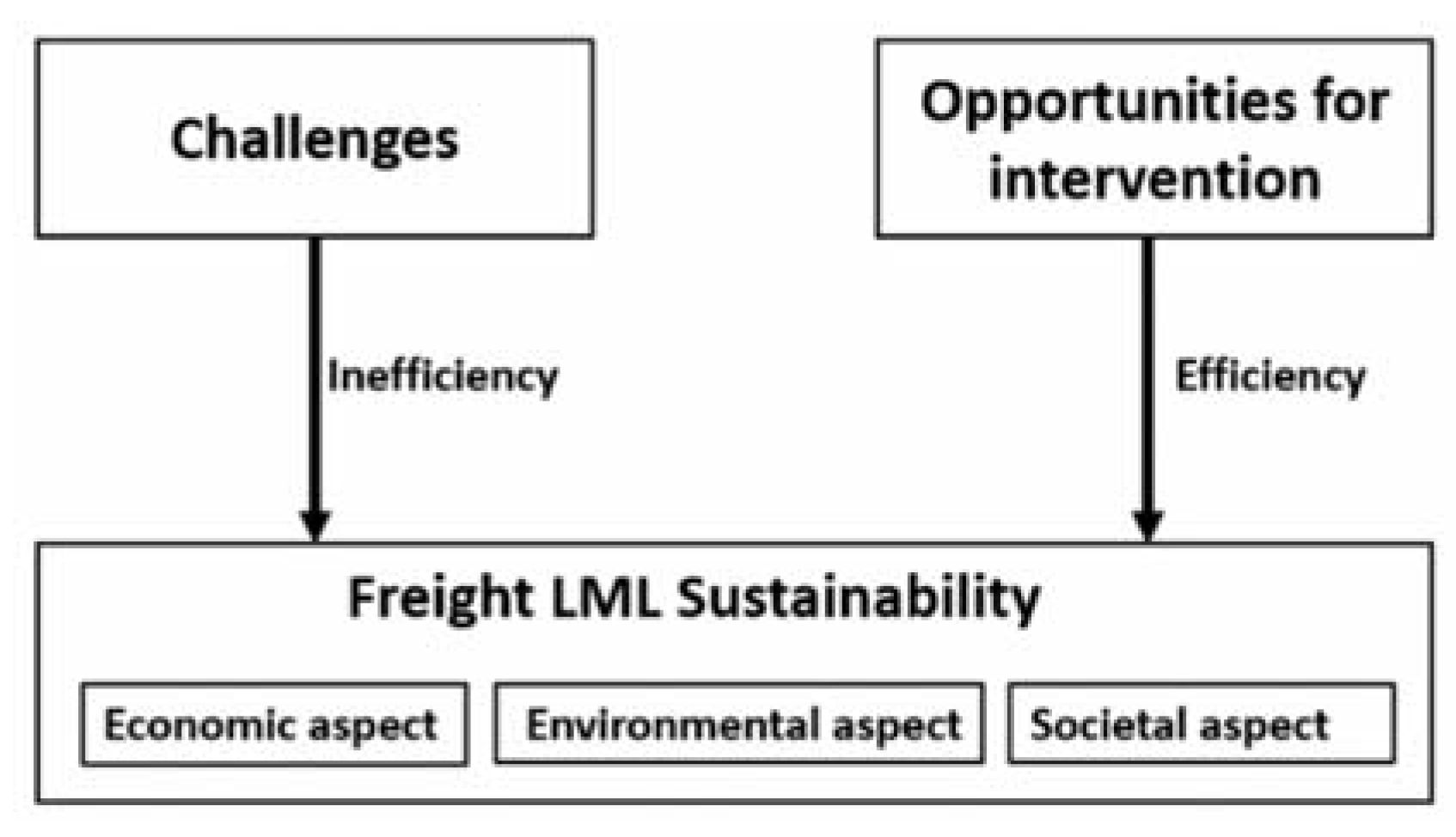


| Search Keyword | Source | Total Hits | <2010 | 2010–2014 | ≥2015 |
|---|---|---|---|---|---|
| Last mile deliver * AND review * | Scopus | 18 | 1 | 3 | 14 |
| Last mile deliver * AND review * | Web of science | 18 | 1 | 6 | 11 |
| Last mile logistic * AND review * | Scopus | 26 | 1 | 2 | 23 |
| Last mile logistic * AND review * | Web of science | 31 | 1 | 4 | 26 |
| Last mile deliver * AND Urban logistic * | Scopus | 112 | 4 | 3 | 95 |
| Last mile deliver* AND Urban logistic* | Web of science | 115 | 4 | 10 | 101 |
| Type of LML Configuration | Illustration | Description |
|---|---|---|
| Type-I (option-1) | 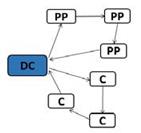 | DC Delivery: DCs distribute the parcels directly to consumers home or PPs. [2,32]. |
| Type-I (option-2) | 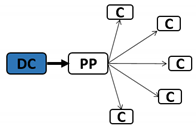 | DC Delivery (option-2): DCs distribute parcels only to PPs from where customers pick up their items. |
| Type-II (option-1) | 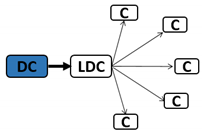 | LDC Delivery (option-1): DCs distribute parcels to LDCs from where customers pick up their items. Delivery scheme could be used from DC to LDCs. |
| Type-II (option-2) | 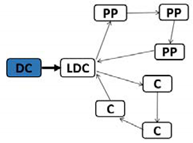 | LDC Delivery (opition-2): DCs carry parcels to LDCs and then the parcels will be distributed to customers home or PPs [19]. |
| Type-III | 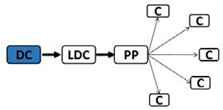 | PP Delivery: Parcels are carried from LDC to and stored at nearest PPs and then picked up by customers [4,19]. |
| Category | Description | Reference |
|---|---|---|
| Technological | Speed and capacity limitations of cargo bicycles and health problems when excess load weight is applied. | [22] |
| Emerging new technologies have potential to highly disrupt the existing urban freight LML systems. Example, application of 3D printing and unmanned aerial vehicles (UAVs) or drones | [36] | |
| Challenges of goods delivery planning and execution associated to rapidly growing online and OC retailing businesses e.g., difficulty to handle fragmented and many small quantity orders that come from online customers | [3,4,6] | |
| Integrating the emerging new technologies such as digitization and automation into LML system design and operation strategies is not easy | [13] | |
| Infrastructural | Difficulty to change infrastructures (e.g., road network, loading/unloading facilities) in existing cities to accommodate increasing freight volume and changing distribution systems | [2,37] |
| Strict regulations in relation to freight distribution, and limitation of facilities | [35,37] | |
| Limitation of space and access in urban areas | [7] | |
| New technologies such as electric vehicles and cargo cycles need new infrastructures such as recharging infrastructure and new road network | [22] | |
| Impedances due to conditions such as geographical difficulties and historical centers | [22] | |
| LML system and management | Difficulty in addressing competing interest of potential actors of urban freight logistics chain regarding services, policies and interventions | [16,21,23,37] |
| Problems related to vehicle routing, vehicle utilization and fleet management, inventory and warehousing, as well as order management | [38] | |
| Establishing coordination between actors is difficult due to uncertainty and dynamic conditions of freight LML | [39] | |
| Lack of understanding on LML and how to design best LML models by some companies | [12] | |
| Acquisition of accurate and adequate data on LML operations and related impacts | [20,40] | |
| Delivery failure (return) and repeated delivery, especially the return rate is high in case of online shopping | [4,6,14,19] | |
| Complex order fulfillment associated to online and OC retailing (e.g., in grocery retailing) | [10] | |
| Long time of goods delivery | [4] | |
| Possibility of increased transport distance due to online shopping which allows goods to be sourced from anywhere around the Globe | [9,36,40] | |
| Increased networking of companies due to application of Industry 4.0 could make logistics solutions of supply chains more complex. | [17] | |
| Less acceptance (by customers) of cargo cycles as a suitable mode of transport | [41] | |
| Logistics cost | Unmanned Airal Vehicles (UAV) based delivery is more expensive compared to van-based delivery. For instance it needs additional investment cost for facilities such as landing stations for drones. | [36] |
| New technologies could lead to the need of new transportation and logistics facility infrastructures of high investment cost. | [21,22] | |
| High fleet acquisition and operational cost of electric light vehicles for some firms | [22] | |
| High cost associated to online and OC grocery retailing | [10] | |
| Rejection (by online retailers) of some delivery orders due to limited LML service capacity | [5] | |
| High cost of first and repeated deliveries | [4] |
| Item | Delivery Failure Rate (%) |
|---|---|
| Books | 3 |
| Small electrical items | 5–10 |
| Fashion clothing | 20–44 |
| Grocery (first time delivery) | 34 |
Publisher’s Note: MDPI stays neutral with regard to jurisdictional claims in published maps and institutional affiliations. |
© 2020 by the author. Licensee MDPI, Basel, Switzerland. This article is an open access article distributed under the terms and conditions of the Creative Commons Attribution (CC BY) license (http://creativecommons.org/licenses/by/4.0/).
Share and Cite
Bosona, T. Urban Freight Last Mile Logistics—Challenges and Opportunities to Improve Sustainability: A Literature Review. Sustainability 2020, 12, 8769. https://doi.org/10.3390/su12218769
Bosona T. Urban Freight Last Mile Logistics—Challenges and Opportunities to Improve Sustainability: A Literature Review. Sustainability. 2020; 12(21):8769. https://doi.org/10.3390/su12218769
Chicago/Turabian StyleBosona, Techane. 2020. "Urban Freight Last Mile Logistics—Challenges and Opportunities to Improve Sustainability: A Literature Review" Sustainability 12, no. 21: 8769. https://doi.org/10.3390/su12218769
APA StyleBosona, T. (2020). Urban Freight Last Mile Logistics—Challenges and Opportunities to Improve Sustainability: A Literature Review. Sustainability, 12(21), 8769. https://doi.org/10.3390/su12218769





